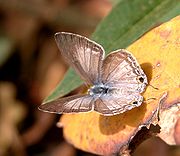
Catochrysops strabo
Encyclopedia

Lycaenidae
The Lycaenidae are the second-largest family of butterflies, with about 6000 species worldwide, whose members are also called gossamer-winged butterflies...
family. It is found in Ceylon, India
India
India , officially the Republic of India , is a country in South Asia. It is the seventh-largest country by geographical area, the second-most populous country with over 1.2 billion people, and the most populous democracy in the world...
, from Sikkim
Sikkim
Sikkim is a landlocked Indian state nestled in the Himalayan mountains...
to Indochina
Indochina
The Indochinese peninsula, is a region in Southeast Asia. It lies roughly southwest of China, and east of India. The name has its origins in the French, Indochine, as a combination of the names of "China" and "India", and was adopted when French colonizers in Vietnam began expanding their territory...
and in Sundaland
Sundaland
Sundaland is a biogeographical region of Southeastern Asia which encompasses the areas of the Asian continental shelf that was exposed during the last ice age. It included the Malay Peninsula on the Asian mainland, as well as the large islands of Borneo, Java, and Sumatra and their surrounding...
, Sulawesi
Sulawesi
Sulawesi is one of the four larger Sunda Islands of Indonesia and is situated between Borneo and the Maluku Islands. In Indonesia, only Sumatra, Borneo, and Papua are larger in territory, and only Java and Sumatra have larger Indonesian populations.- Etymology :The Portuguese were the first to...
and the Philippines
Philippines
The Philippines , officially known as the Republic of the Philippines , is a country in Southeast Asia in the western Pacific Ocean. To its north across the Luzon Strait lies Taiwan. West across the South China Sea sits Vietnam...
.
The wingspan
Wingspan
The wingspan of an airplane or a bird, is the distance from one wingtip to the other wingtip. For example, the Boeing 777 has a wingspan of about ; and a Wandering Albatross caught in 1965 had a wingspan of , the official record for a living bird.The term wingspan, more technically extent, is...
is 25–30 mm.
The larvae feed on Ougeinia dalbergioides, Schleichera trijuga and Desmodium
Desmodium
Desmodium is a genus in the flowering plant family Fabaceae, sometimes called tick-trefoil, tick clover or beggar lice. There are dozens of species and the delimitation of the genus has shifted much over time....
species.
Subspecies
- Catochrysops strabo strabo
- Catochrysops strabo celebensis (Halmahera, Obi)
- Catochrysops strabo luzonensis (Philippines)
Description

Male
Upperside: Pale violet with in certain lights a blue, slightly-silvery sheen. Fore wing: a slender anticiliary dark line. Hind wing: interspace 1 with a short transverse subterminal brown bar edged inwardly with white; interspace 2 with a prominent round black spot edged very faintly on the inner side by a diffuse bluish lunule; the dark subterminal spots of the underside apparent through transparency; an anticiliary slender jet-black line more conspicuous than in the fore wing, in some specimens edged inwardly in the posterior interspaces with white; this line is present in interspaces 1 and 2 in all specimens. Cilia of both fore and hind wings white transversely traversed medially by a brown line; tail black tipped with white._in_hyderabad_w_img_4729.jpg)
Female

_in_hyderabad_w_img_4615.jpg)
Distribution
Peninsular India south of the outer ranges of the Himalayas; Ceylon; Assam ; Burma; Tenasserim; the Andamans; Nicobars; extending through the Malayan Subregion down to Australia.Larva
"Of the usual shape (i. e. onisciform); head light yellow margined with brown; body light rose, covered with tiny star-topped stems so arranged as to make diagonal whitish lines to each segment; a subdorsal line on the back; anal segment nearly square, the margins of the body clothed with light coloured and longish hair" (Davidson, Bell & Aitken.)Pupa
"Of the usual form, covered with stiff erect hair; colour light rose with a black patch on the second segment and centre of thorax; it has also a dark dorsal line and the lower segments are smudged with black" (Davidson, Bell & Aitken.)External links
- http://www.asahi-net.or.jp/~EY4Y-TKNM/philframe.htmlPhotos of C. strabo from the PhilippinesPhilippinesThe Philippines , officially known as the Republic of the Philippines , is a country in Southeast Asia in the western Pacific Ocean. To its north across the Luzon Strait lies Taiwan. West across the South China Sea sits Vietnam...
] - Species info

